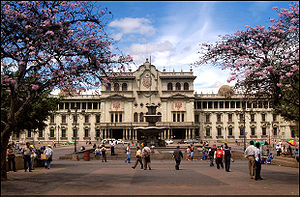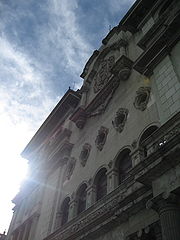.gif)
National Palace (Guatemala)
Encyclopedia

Guatemala City
Guatemala City , is the capital and largest city of the Republic of Guatemala and Central America...
's symbol in its monumental architectural context. It was the most important building in Guatemala and was the headquarters of the President of Guatemala. The building is the origin of all the roads in the Republic, and has a spot known as Kilometro Cero (Zero Kilometer).
It is actually a museum and is also used for important acts of the government.
History

Then in 1549, President Alonso López de Cerrato moved the Audiencia de los Confines, from Gracias a Dios
Gracias a Dios
Gracias a Dios: Thanks to God, may refer to.*Gracias a Dios Department, a department of Honduras.*"Gracias a Dios", a song by Mexican singer Thalía...
in Nicaragua
Nicaragua
Nicaragua is the largest country in the Central American American isthmus, bordered by Honduras to the north and Costa Rica to the south. The country is situated between 11 and 14 degrees north of the Equator in the Northern Hemisphere, which places it entirely within the tropics. The Pacific Ocean...
to Santiago de Guatemala.
and in 1761 the President Alonso Fernández de Heredia, began the construction of a new seat, under direction of Spanish Captain and engineer Luis Diez de Navarro.
In celebration of the first century of independence in 1919, President Manuel Estrada Cabrera
Manuel Estrada Cabrera
Manuel José Estrada Cabrera was President of Guatemala from 8 February 1898 to 15 April 1920.Manuel Estrada forcibly took the presidency after the assassination of José María Reina. The Guatemalan cabinet called an emergency meeting to appoint a new successor, but declined to invite the General...
, placed the first stone for a future palace next to the Plaza de la Constitución.
The Italian architect Guido Albani was charged with designing the palace, but it never came to pass due to the collapse of the government soon thereafter. Two years later, in 1921, President Carlos Herrera with the Centenary very close ordered the Palacio del Centenario to be built in only three months time with a small budget and few resources. It became popularly known as the Palacio de Cartón (Carton Palace). However, in 1925 it was destroyed by a fire.
Then in 1927 President Lazaro Chacón declared a contest for the design of a new palace. The contest was won by the artist Agustín Iriarte, but this project again never came to be.
Finally, in 1932, the President General Jorge Ubico
Jorge Ubico
Jorge Ubico y Castañeda was a Guatemalan dictator who held the title of President of Guatemala from 14 February 1931 to 4 July 1944.-Early years:...
, published the basis for the design and construction of the palace, and on July 4, 1937 the first stone was placed. The National Palace was built between January 1939 and 1943. On November 10 of that year the present-day Palace was opened.

